1. The climate justice ecosystem
“Climate Justice” is not just a concept but a movement. There is a growing network of people and organisations who are growing together. No single organisation can be “climate-just” on its own, nor can it be expected to address all aspects of climate change, therefore, it is vital to support and collaborate with other organisations. In this way, “Climate Justice” can also be understood as an ecosystem – a web of action. This page will re-imagine organisations as members of an ecosystem before introducing some organisations that already exist within the Australian landscape.
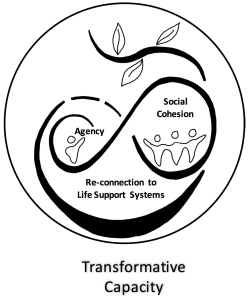
(Source: Moving from Adaptive to Transformative Capacity:
Building Foundations for Inclusive, Thriving, and Regenerative Urban Settlements)
2. Imagining the climate justice ecosystem
The first step in any “climate justice” journey is reconnecting with the planet. This reconnection may be as small as appreciating bird calls in the morning or as large as writing an environmental policy submission. Another way to reconnect with the planet is to reimagine your role within it. Every organisation and every person who works in that organisation are nested ecosystems – networks within networks. Different staff members have different roles, just as different organisations have different goals. Imagining the climate justice movement as an ecosystem to which you/your organisation belongs is the first step to “join” it!
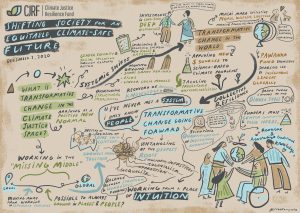
(Source: Climate Justice and Resilience Fund)

(Source: Australia reMade)
Read more:
3. Organisations within the climate justice ecosystem
No two climate organisations are the same – not all of them will align with each other depending on organisational values, dynamics, theories of change, or understandings of “climate justice”. The following table has a list of some organisations. You can support and/or collaborate with these organisations, follow their campaigns and advocacy, or simply be aware of their existence within the ecosystem.
| Organisation | Description |
|---|---|
| Seed Mob | Australia’s first Aboriginal and Torres Strait Islander youth-led Climate Justice network. |
| Climate Justice Union (CJU) | WA’s first community-based Climate Justice organisation. |
| Australian Youth Climate Coalition (AYCC) | A youth-led network advocating for Climate Justice. |
| 350 Perth (Boorloo) | Part of a global movement promoting climate solutions. |
| Get Up Australia | A movement supporting progressive policies and community democracy. |
| Lock the Gate | A national organisation protecting land, water, and air from harmful coal and gas projects. |
Find more organisations and projects involved in climate justice and resilience below.
Western Australia Actors – Climate Justice
Centre for People, Place and Planet – Edith Cowan University
Climate Action Network Australia (cana)
Energy Transformation Association for the Kimberley
The Western Australian Advocacy for Consumers of Energy Forum (WA ACE Forum) brings together energy consumer advocates to share consumers’ views and contribute to WA’s energy debate.
Australian Youth Climate Coalition (AYCC) – WA Group
WA Healthy Environments and Lives Network (HEAL)
Australian National Actors – Climate Justice
HEAL network – Healthy environments and lives (Telethon Kids Institute)
Water Justice Hub – Dr Anne Pooelina
Australian Food Sovereignty Alliance
Australian Psychological Society
Environmental Justice Australia
Australian Packaging Covenant Organisation Ltd.
Australian Youth Climate Coalition
Insurance Council Australia – Help in a disaster
Aboriginal and Torres Strait Islander Actors (Australia-Wide)
Healthy Environments and Lives Network
Indigenous Youth-Led Climate Network
International Climate Justice Actors
Women Earth and Climate Action Network International
Alliance for Transformative Action on Climate and Health (ATACH)
Asian Pacific Adaptation Network
4. How do we know that movements work?
Movements have consistently reshaped history, achieving vital wins for human and environmental rights.
They are not limited to street protests but encompass diverse activities, such as:
- Marginalised groups leading advocacy campaigns.
- Aboriginal and Torres Strait Islander peoples advocating for self-determination and equity.
- Researchers producing evidence-based studies.
- Community organisations raising awareness and mobilising action.
- Legal professionals addressing injustices through the courts.
- Everyday people writing letters to MPs or participating in grassroots organising.
Movements achieve change through collective effort and solidarity.
Examples of past transformative movements include:
- Generations of Aboriginal Resistance.
- The Worker’s Rights Movement.
- Environmental Protests.
- Gender and Sexuality Protests.
- Civil Rights Movements.

(Source: A bibliometric and topic analysis of climate justice: Mapping trends, voices, and the way forward)
5. Understanding real and false climate justice solutions
Navigating climate action and adaptation strategies can be challenging, especially when fossil fuel industries shift responsibility from governments to individuals. To build clarity, we have included two resources:
6. Dimensions of climate justice and reflective consideration
The document below can help provide a deeper understanding of the relational, recognitional, procedural, and intergenerational dimensions of climate justice.
It provides reflective questions to consider. Reflection is key to integrating these dimensions into organisational practices.
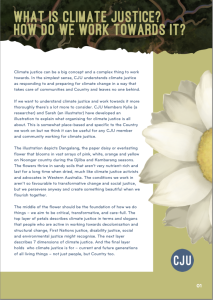 Access the full document here.
Access the full document here.
Read more
For further learning, explore:
